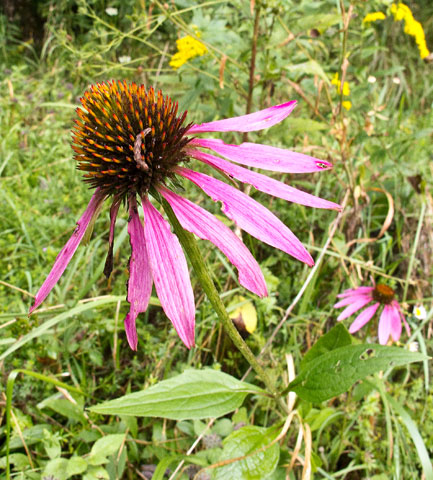 Purple Coneflower
Purple Coneflower
Echinacea purpurea
From Illinois Wildflowers
This is a perennial plant up to 3½' tall that branches occasionally. The light green stems have small purple streaks and scattered white hairs. The alternate or opposite leaves are up to 6" long and 3" across, becoming smaller as they ascend the stems. The leaves are ovate to lanceolate in shape and their margins have widely spaced teeth (or less often, they lack teeth). The upper leaf surface is olive or dark green with minute appressed hairs. The petioles are short and slightly winged.
Upper stems terminate in individual flowerheads spanning about 2½-4" across. These flowerheads have long naked peduncles (flowering stalks) up to 8" long; the peduncles have scattered hairs like the stems. Each daisy-like flowerhead has 10-20 ray florets that surround a large central cone of numerous disk florets. The central cone is yellowish brown to reddish brown, somewhat flattened, and very prickly. The petaloid rays are purple, narrowly oblong, and they tend to droop downward with age. Around the base of each flowerhead, there are numerous floral bracts (phyllaries) that are arranged in several layers. These bracts are green, hairy, and narrowly lanceolate, becoming recurved when the flowerhead blooms. The blooming period begins in mid-summer and lasts about a month, after which there is a temporary dormancy. Later, some plants may bloom again during the early fall. In bright sunlight, the flowerheads are mildly fragrant. Afterwards, the disk florets are replaced by dark achenes that are narrow and flat; they lack tufts of hair. At this time, the seedhead is prickly and dark-colored. The root system is fibrous and short-rhizomatous. Small dense colonies of plants may form from the rhizomes.